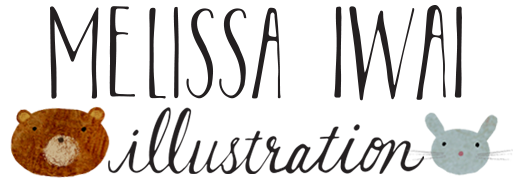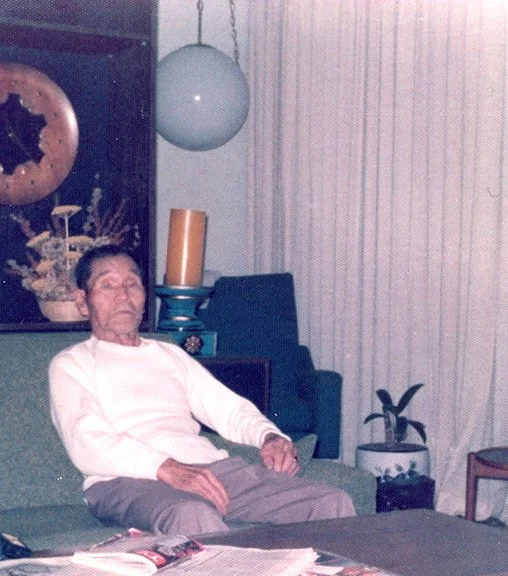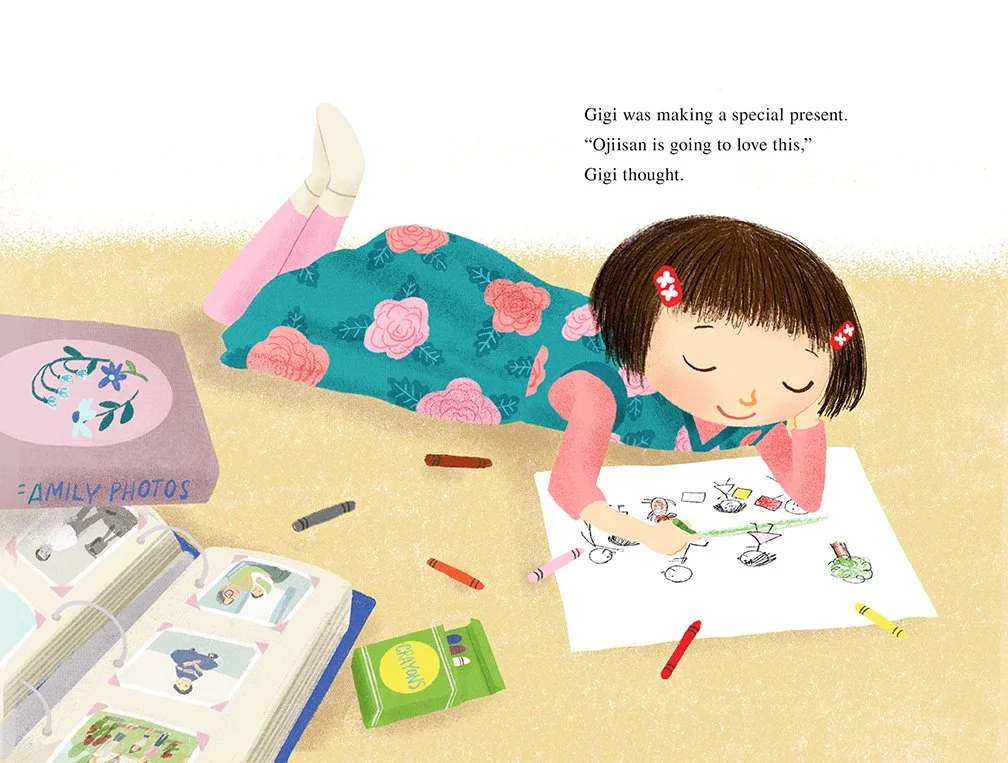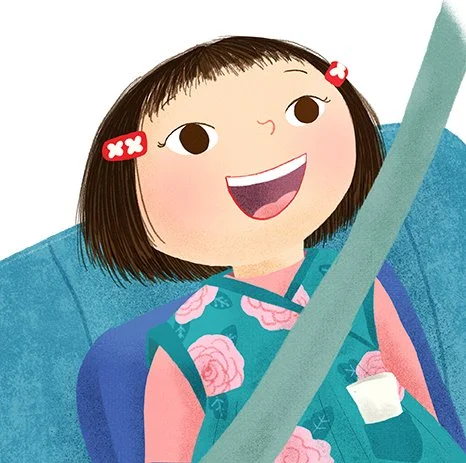Two years ago, during lockdown, I finally sold a story that I had be exploring for years. And more than just a story, I sold an idea for a four-book deal with Harper Collins! It was definitely a lucky break: My amazing editor, Tamar Mays, was looking for a new I Can Read series based on a character of color to add to their growing diverse books list. She reached out to my agent, Christy Ewers at The Cat Agency who then shared the call for submissions with our group.
I had been kicking around an idea for years that I thought would work.
It was inspired by a childhood memory of when my Japanese grandfather came to stay with my family for a while in California. He immigrated to Hawaii at the turn of the century like so many Japanese people at the time. Both of my parents were born and raised in Honolulu.
We called my mom’s father Ojiji –a nickname form of Ojiisan (“grandfather”), kind of like “grandpa” in Japanese. Ojiji didn’t speak much English at all even though he lived in Hawaii for years. My parents grew up speaking mainly English. They used a rudimentary form of Japanese at home, but because they grew up during WWII, they weren’t allowed to speak Japanese in public or learn how to read or write it. My brother and I weren’t raised hearing or speaking the language. When Ojiji lived with us, it was a challenge to communicate, but we somehow managed using a mix of English, Japanese, and some Hawaii words thrown in the mix. The experience made a huge impression on me at that young age.
I was about five, and it was the first time I had interacted with a non-native English speaker. Also, Ojiji seemed so different from the grandparents I read about in books or saw on TV!
Me, Ojiji, my mom eating candy and watching TV.
This memory is the inspiration for Gigi and Ojiji, the first book in the series of I Can Read books with Harper Collins. Gigi is somewhat based on my child self, but she is totally fictional, as are the other characters in the book. We both love to draw, but she is a completely different person!
Gigi is biracial – her mom is Japanese and her father is White. She has big emotions and is much more expressive than I was at that age. She doesn’t hold back on saying what she’s thinking and feeling.
From Gigi and Ojiji by Melissa Iwai 2022
The stories chronicle how she and her Ojiji learn from each other.
Having empathy and being open to differences is so important. I hope Gigi and Ojiji can give kids some understanding about Japanese culture and language. I hope that kids who come from that background feel seen. And I hope that all readers will see how we all have the same feelings, regardless of cultural differences.
But why did it take SO long to write such a short story you might ask?
I mentioned that I wanted to write a story based on this premise years ago. I tried it as a picture book, a chapter book, and I even started it as a middle grade novel with an older girl, but I never finished it.
Looking back, I realize that one of the problems I was creating for myself was being hypercritical during the first draft phase. I had expectations of what it should look like during the writing process, and when it wasn’t meeting my expectations, I’d get so frustrated and either give up or push through. It made the whole endeavor a slog, to be honest.
From Gigi and Ojiji by Melissa Iwai 2022
So how did I finally figure out how to make the manuscript for Gigi and Ojiji work and actually sell it years later?
Part of the answer is boring: I wrote more. I wrote other stories. Many of them, also unsold sit in the proverbial drawer waiting. I took classes. I read of lot of children’s books. By the time I did write the current version of Gigi and Ojiji, I had written several other books that were published. So when I picked my old manuscript up again two years ago, I just had more experience—and more hours put into the writing process.
Another part of the answer is obvious: I changed my mindset when sitting down to write. For some people, creating is such a natural thing— like drinking water. I envy people like that. It’s not so hard if I am creating just for myself, but when it needs to be approved by a creative team, I fully admit that it’s easy for me to get tripped up in my head whether it’s writing or illustration.
Every time I start a new book project, I often question my ability to be able to do it.
Does this sound familiar?
If not, kudos to you! For everyone else, take note: Don’t beat yourself up about it. It’s just a habit you developed at some point. I’ve been illustrating and writing children’s books for over twenty years, and it always happens.
What helps me is to just acknowledge it and then ignore it.
I am getting much better at thinking, “OK, this is that thing I always do…” and move on.
Learning to shut down the critical voice in my head during the beginning of a project is something that’s been incredibly helpful to how I approach any creative pursuit, whether it’s writing or painting. I focus on the process rather than the final product during my first draft. This involves not listening to that critical voice and letting go of the anxiety of needing to create something ‘great’. I’m always fighting my tendency to self-edit and judge while I work. I need to remember that there’s time for play, experimentation and exploration, and there is time for editing and constructive criticism.
What’s important is to not to mix up the order.
In the past, I would often get fixated on details too early, and struggle to complete it. I would set the story aside and never revisit it because I didn’t enjoy the process. Now, I just try to make the experience enjoyable by letting go of expectation and attachment to a specific result.
From Gigi and Ojiji by Melissa Iwai 2022
Another related aspect of how I was able finish this manuscript, was surprising: Working within the parameters of an I Can Read book was very freeing for me.
If you have kids who read leveled reading books, or you teach with them, you already know that there are certain conventions the stories must follow. There is limit to the number of sentences per page and spread. There is a limit to the number of characters, spaces, and punctuation per line. And there is a limit, depending on the level, as to the complexity of the vocabulary and sentence structure of the stories.
What I found when writing these stories is that these “rules” limited my choices – in a good way!
Much like how painting in a limited palette can be freeing for artists (you don’t have to spend too much time choosing colors!) I found the same to be true with my writing. And trying to sort out how to fit the story idea into such a framework gave my left brain a task to do that was more productive than criticizing what I was writing during the process.
I wrote the story and submitted it with some future story ideas and a few sample pieces of art. And that’s how I finally sold my manuscript! I am in the process of illustrating the second book, and I’ve just turned in the manuscript for the third book.
All in all, it’s been such an enjoyable experience! I hope I have an opportunity to write many more Gigi and Ojiji stories in the future.
Are you a writer? What are some things you do to overcome self-editing and hypercritical observations while you write?
Are you an artist? Are you one of the lucky ones that rarely struggle with this? Leave a comment below. I would love to hear about your experiences!
Gigi and Ojiji is available for pre-order. I hope you check it out and please share the news!







